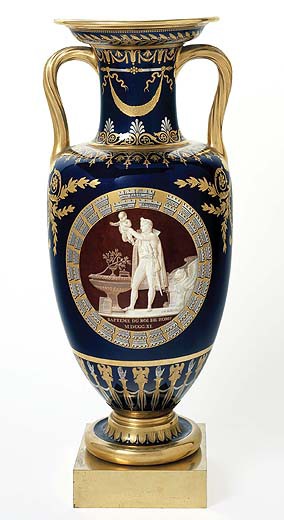Full title: ‘Etruscan carafe’ vase, fine blue ground, roundel representing the Roi de Rome baptism medal painted in the cameo style.
This vase was painted in 1812, and the Emperor gave it as a new year’s gift in 1813 to Comtesse de Noailles, who had been appointed Lady in waiting to the Empress Marie-Louise the preceding year. Queen Hortense described the countess in her Mémoires as «Madame Just de Noailles, who was always kind and good». The Comtesse de Noailles’s maiden name had been Françoise-Xavière-Mélanie-Honorine de Talleyrand-Périgord (1785-1863). She was Talleyrand’s niece, and in 1803 she married Antoine-Claude-Dominique-Just de Noailles (1777-1846), the second son of the Duc de Mouchy, whom Napoleon made one of his chamberlains in 1806 and then Comte de l’Empire in 1810.
The form of the vase, called Etruscan carafe, is an exact replica of a Greek vase from the collection which Denon sold to the king in 1785. This vase was deposited at the manufactory the following year with the aim of encouraging the artists to give better imitations of Antiquity. The central motif of the vase is a copy of the official medal cast by the Paris Mint and engraved by Bertrand Andrieu (1761-1822) after a drawing by Louis Lafitte (1770-1828); Andrieu exhibited the medal at the Salon of 1812. The painting of the vase was entrusted to Jean-Marie Degault or De Gault (1765-1818), a painter at the Sèvres manufactory from 1808 to 1817 who specialised in the imitation of cameos and hard stones. Degault managed to combine on a single medallion both the obverse and reverse of the original medal, placing forty-nine crowns symbolising the principle towns of the empire around the figure of the Emperor holding his son above the baptismal font, and capping the composition with the names of Paris, Rome and Amsterdam. He received 300 F for his work. The ornaments on the vase were painted by Claude-Antoine Déperais, ornament painter at the Sèvres manufactory from 1798 to 1822, and the hands of justice around the belly of the base were done by Jean-François Davignon, active from 1807 to 1813. The bronze work was done by the celebrated goldsmith Thomire. The vase went on sale on 28 December, 1812 at a cost price of 850 F and a buyer’s price of 1,200 F.
Bernard Chevallier (tr. P.H.)
Conservateur général du patrimoine (emeritus)
February 2008
Have a look at our close-up on the birth of the Roi de Rome.


